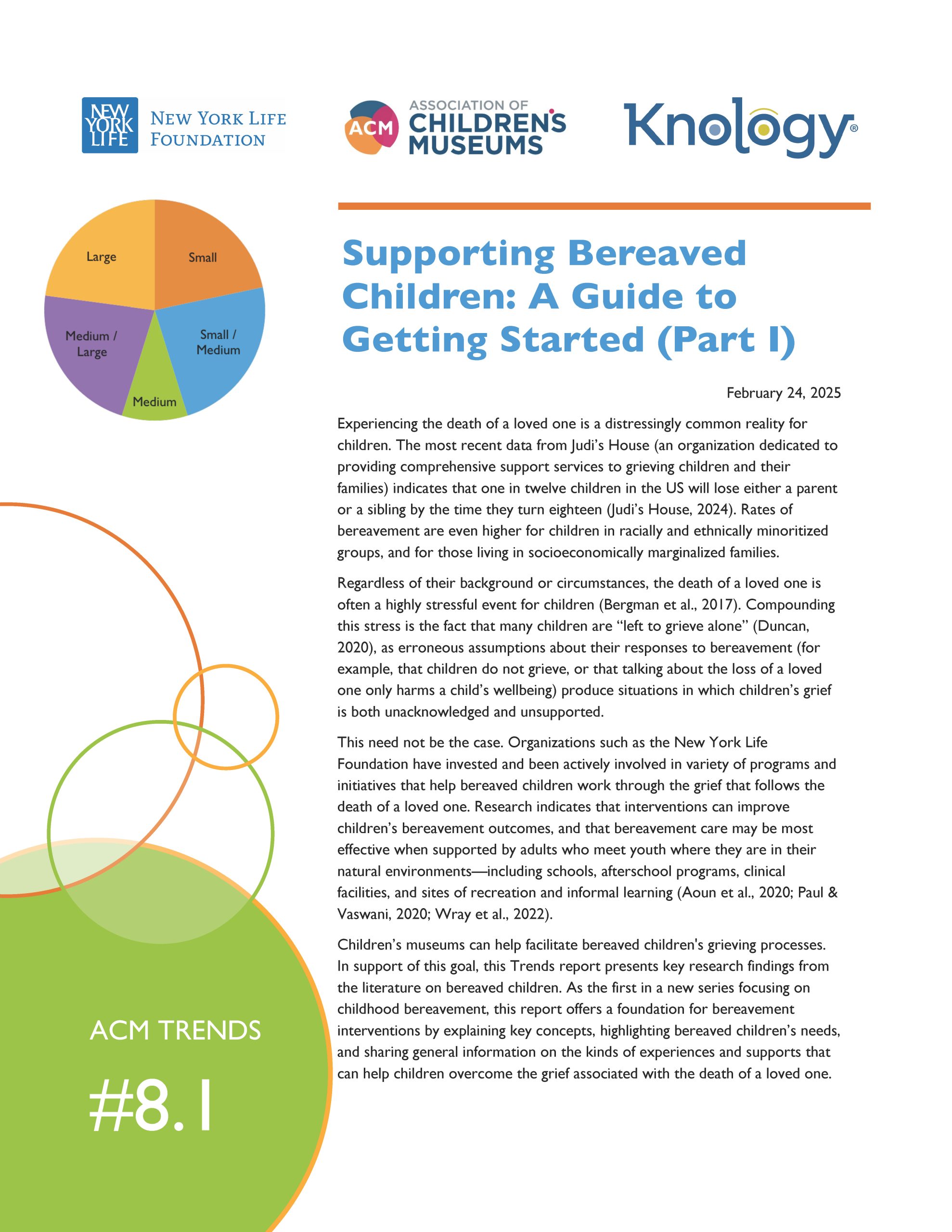
Data from this report was collected through a search of available literature. The research was supported by funding from the New York Life Foundation.
Experiencing the death of a loved one is a distressingly common reality for children. The most recent data from Judi’s House (an organization dedicated to providing comprehensive support services to grieving children and their families) indicates that one in twelve children in the US will lose either a parent or a sibling by the time they turn eighteen (Judi’s House, 2024). Rates of bereavement are even higher for children in racially and ethnically minoritized groups, and for those living in socioeconomically marginalized families.
Children’s museums can help facilitate bereaved children’s grieving processes. In support of this goal, this Trends report presents key research findings from the literature on bereaved children. As the first in a new series focusing on childhood bereavement, this report offers a foundation for bereavement interventions by explaining key concepts, highlighting bereaved children’s needs, and sharing general information on the kinds of experiences and supports that can help children overcome the grief associated with the death of a loved one
What U.S. industry sees more than 55 million K-12 students come through its doors every year? MUSEUMS!
According to the American Alliance of Museums, 55 million students visit museums each year through school-trips alone. In addition, more than 75% of museum educational budgeting is spent on K-12 education (American Alliance of Museums 2024). This captive audience can be capitalized on through collaborations with colleges and universities, specifically with a focus on promoting public health. Beyond K-12 education, museums offer a large value to public health, including awareness around disease prevention and surveying the public about their perceptions and concerns surrounding healthcare (Behera and Roy 2018).
Children’s museums, specifically, are dynamic spaces that are designed to engage young people, promote critical thinking and creativity through hands-on activities and interactive exhibits. Since the Covid-19 pandemic, children’s museums have begun new partnerships with a variety of community partners including, government agencies, and social and health organizations. Surprisingly, one underutilized collaborator is colleges and universities. In a 2023 trend report by the Association of Children’s Museums, museums reported their frequency with various collaborators and universities were named less than 50 times, with the highest ranked category garnering a total of 150 times (Association of Children’s Museums 2023).
In the 2023 Understanding Museums’ Collaboration Goals ACM Trends Report, museum leaders reported the goals for collaboration, these goals were then grouped into three primary categories: healing, learning and community. This report indicated that universities were only identified in the learning category as collaborators (Association of Children’s Museums 2023). Partnerships with college and universities offer a unique opportunity to leverage the expertise of researchers, educators and students to support the development of programs that emphasize health and wellness across all three primary goals.
Healing
Increasing Community Health & Wellbeing
Focusing on public health, these collaborations can educate young people, their schools, families, and communities on a variety of topics tailored to their community’s needs. Through exhibits and collaborative educational programs, young people can learn about healthy eating, nutrition, exercise, proper hygiene, disease spread and prevention. Public health and other health related faculty can work alongside museum leaders to identify the issues facing the community in an effort to ensure programs are meeting the needs to the community at large.
Tackling Community or Social Issues
College students and educators can serve as mentors and offer support groups for a variety of issues. Peer support groups and mentor-mentee meet ups held at the museum can break down communication barriers while providing children with a consistent support system. Peer support programs focused on children with chronic illnesses or disabilities, children with autism-spectrum disorder, children of military families, or even those interested in a certain career field, can serve as a professional development tool for the college students while also supporting the goals of the museum and the children.
Addressing Traumatic and Tragic Event
Youth mental health and wellbeing is a major public health concern for the United States. According to the CDC (2024), homicide and suicide are the #2 and #3 leading cause of death among adolescents in the United States. Creating safe spaces for children is not something that can be developed by a single entity. Museums can work with college and universities to offer educational sessions about recent events, which can be led by faculty and students who have experience in the area or stories to share. In addition, students can host hands-on interactive sessions as a form of art therapy, where students can express themselves through a variety of mediums.
Learning
Enhancing Formal / Informal Education
Colleges and universities can utilize these partnerships to research and validate the effectiveness of educational programs being offered. Through this data collection they can refine, improve and expand these programs over time, therefore furthering the reach and impact to the public. This also ensures that the resources being allocated for projects are being maximized and evaluated regularly.
Through offering training and professional development for museum staff and other local educators and hosting events which equip them with skills, knowledge and the confidence to deliver public health content, colleges and universities can empower museums to deliver high-quality programming to the students that visit daily.
Developing Virtual Programming
Colleges are no stranger to offering high level educational programs on virtual platforms. Most institutions offer online courses or programs, especially in the wake of Covid-19. In addition, ongoing advances in technology in healthcare presents a unique opportunity to educate children in virtual healthcare settings through the use of augmented reality and virtual reality. Colleges and universities can offer professional development and provide guidance on moving programming to virtual spaces. Students specializing in health science, computer programming, digital media and design and computer science can work alongside museum leadership to assist in the logistics needed to design user-friendly programming that is engaging to children.
Developing In-Person Exhibits / Programs
Museum leaders can invite educators to provide professional insight into exhibits to ensure they are relevant and updated based on current trends and research. College faculty can also work with students to develop and offer educational workshops or long-standing exhibits. Students can work with museums leaders and faculty to tailor these workshops based on the needs of the community.
Community
Reaching New Audiences
Colleges and universities partner with local schools to offer informational sessions and recruit students to attend their institutions. By working collaboratively, museum and college leaders could expand their outreach by connecting schools and communities with each other. Utilizing pre-existing relationships to promote museum programs, exhibits and educational offerings, will help drive traffic to the museum, as well as expanding partnerships with other community partners such as health systems and non-profit organizations. In turn, promoting the college or university at the museum through programming and exhibits will also advertise their commitment to education, specifically around science and health. It will also showcase the expertise and experiences that their students and faculty possess.
Reaching Traditionally Underserved Audiences
Museum leaders can work with college students to assist in outreach efforts to underserved audiences. Through shared collaborations with local non-profit agencies, students can assist in letter-writing campaigns, community service events and community health fairs. College faculty and students can partner with the museum to bring the museum to the classroom and offer educational programs at schools and community centers where transportation may be a barrier to access.
Conclusion
As museum leaders begin to focus and develop their programming framework on the three primary areas of collaboration, I challenge them to work alongside colleges and universities to support these goals. Colleges and universities around the country see record high interest in public health degrees, developing longstanding partnerships can prove to be mutually beneficial and have the potential to have long-term impacts on the community (Leider et al. 2023).
By working together, universities and museums, have the potential to not only elevate their collaboration goals, but also educate young people and promote healthy habits and a public health mindset. If universities and museums strengthen their collaboration across all three goals and work to ensure learning is fun and accessible, we can empower children to take ownership of their health and the health of those around them.
About the Contributor
Trish Lemmerman, Ed.D, MPH
School of Pharmacy and Health Services, Fairleigh Dickinson University
www.linkedin.com/in/patricialemmerman | www.fdu.edu/fdu-health/
Trish Lemmerman, Ed.D, MPH has worked in higher education for over 17+ years. Through her experience she has worked with both undergraduate and graduate students across all fields. Over the past 8 years, she has worked alongside graduate students in the fields of pharmacy, physician assistant, occupational therapy, social work and public health. For the past year, she has also been working collaboratively with a local children’s science museum, Liberty Science Center, to offer educational programming, mentorship opportunities, and bridge the gap between higher education and children’s museums.
Liberty Science Center is a 300,000 square foot learning center located in Jersey City, New Jersey,. It is home to 12 exhibition halls, a live animal collection with 110 species, giant aquariums, a 3D theater, live simulcast surgeries, hurricane- and tornado-force wind simulators, K-12 classrooms and labs, teacher-development programs, and the Western Hemisphere’s biggest planetarium—the Jennifer Chalsty Planetarium and LSC Giant Dome Theater.
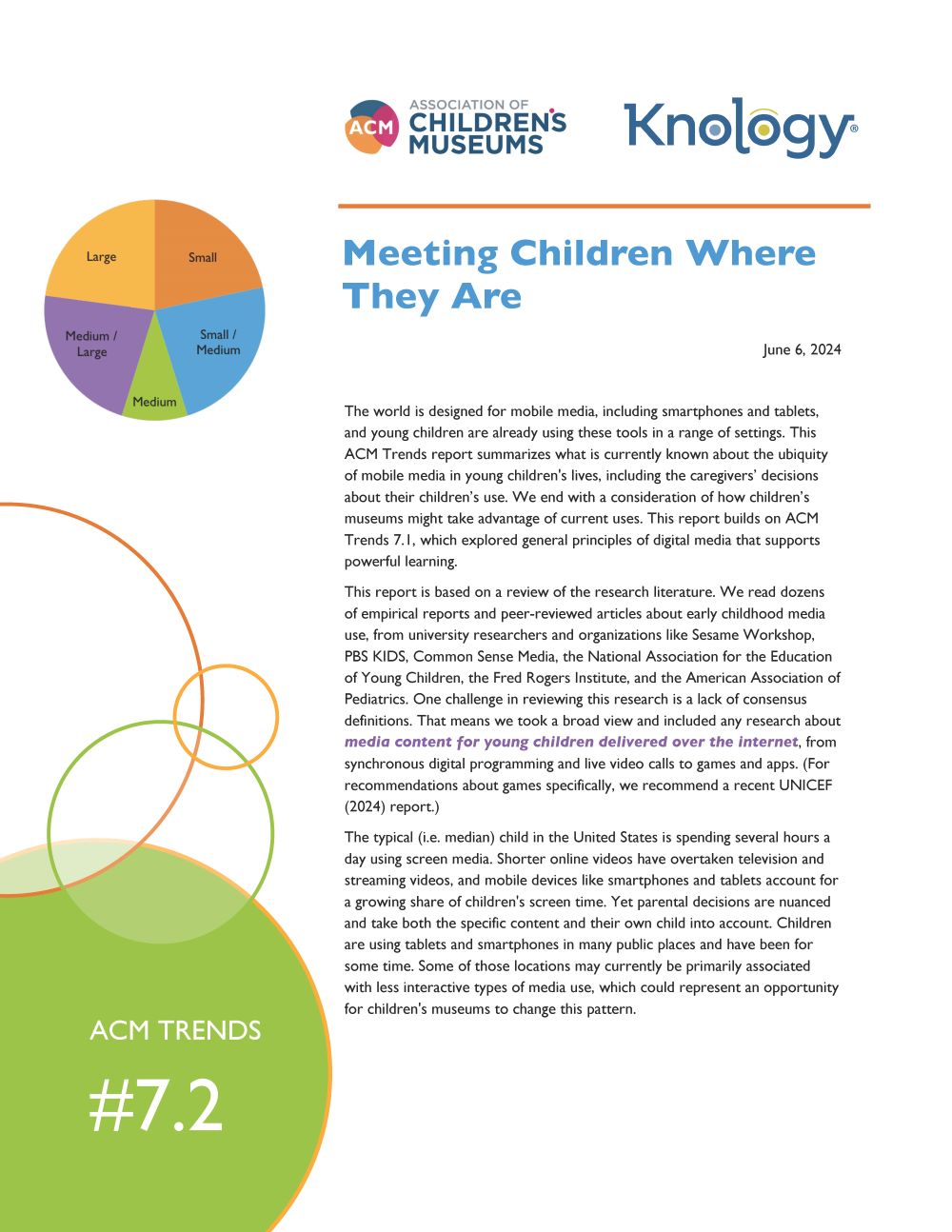
Data for this report was collected through a search of available literature. This research was supported by the Institute for Museum and Library Services.
The world is designed for mobile media, including smartphones and tablets, and young children are already using these tools in a range of settings. This ACM Trends report summarizes what is currently known about the ubiquity of mobile media in young children’s lives, including the caregivers’ decisions about their children’s use. We end with a consideration of how children’s museums might take advantage of current uses. This report builds on ACM Trends 7.1, which explored general principles of digital media that supports powerful learning.
This report is based on a review of the research literature. We read dozens of empirical reports and peer-reviewed articles about early childhood media use, from university researchers and organizations like Sesame Workshop, PBS KIDS, Common Sense Media, the National Association for the Education of Young Children, the Fred Rogers Institute, and the American Association of Pediatrics. One challenge in reviewing this research is a lack of consensus definitions. That means we took a broad view and included any research about media content for young children delivered over the internet, from synchronous digital programming and live video calls to games and apps.

Data for this report was collected through a review of existing literature. This research was supported by the Institute for Museum and Library Services.
When designed well, virtual programming and online experiences can facilitate meaningful learning moments in early childhood.
This ACM Trends report focuses on these digital media as one educational tool in the museum toolkit. Several well-regarded early childhood organizations have endorsed particular uses of media even for very young children, and we explore the principles and the research behind them before turning to criteria that can help identify when media is the right tool. ACM Trends 7.2 will build on this report by looking at empirical questions that must inform design: how often children use media, which children use media, and where children use media.
This Trends report reviews the research findings and concludes with practical advice for children’s museums seeking to design meaningful digital media experiences for young children.
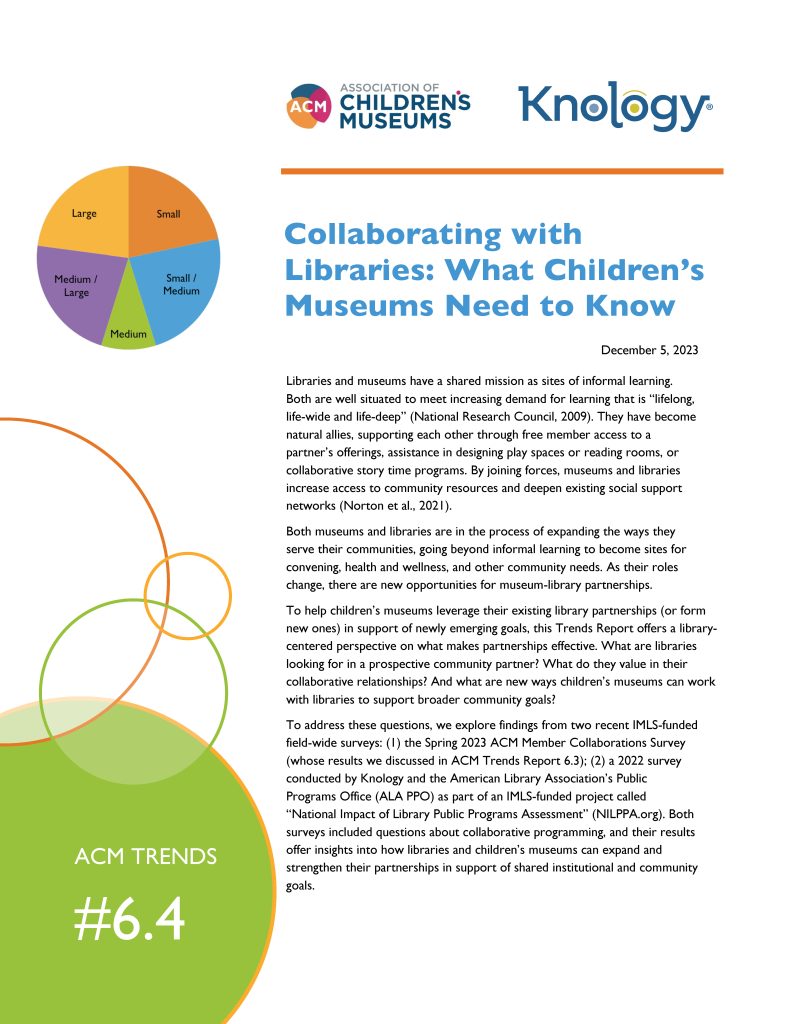
Data for this report comes from two surveys. That pertaining to children’s museums’ collaborations with libraries was collected through the Spring 2023 ACM Member Collaborations survey. The dataset contains information from 59 member institutions. Data on library collaborations with museums was collected through a NILPPA survey of US libraries conducted in 2022. This dataset contains information from 314 libraries. Research for both of these projects is supported by the Institute for Museum and Library Services (Grant #s: MG-251839-
OMS-22; MG-80-19-0042-19; LG-250153-OLS-21).
Libraries and museums have a shared mission as sites of informal learning.
Both museums and libraries are in the process of expanding the ways they serve their communities, going beyond informal learning to become sites for convening, health and wellness, and other community needs. As their roles change, there are new opportunities for museum-library partnerships. To help children’s museums leverage their existing library partnerships (or form new ones) in support of newly emerging goals, this Trends Report offers a library centered perspective on what makes partnerships effective. What are libraries looking for in a prospective community partner? What do they value in their collaborative relationships? And what are new ways children’s museums can work with libraries to support broader community goals?
The survey also offered insights into the goals children’s museums are pursuing through collaboration. Though varying considerably, museums’ collaborative goals are connected to three broadly shared aims: (1) healing; (2) learning; (3) community. In what follows, we discuss how these findings can help children’s museums understand, approach, and evaluate collaborative work. Our hope is that sharing this information will not only stimulate dialogue around collaboration and partnership, but also help children’s museum leaders plan new collaborative programs and begin the process of building relationships with new partners.
To address these questions, we explore findings from two recent IMLS-funded field-wide surveys: (1) the Spring 2023 ACM Member Collaborations Survey (whose results we discussed in ACM Trends Report 6.3); (2) a 2022 survey conducted by Knology and the American Library Association’s Public Programs Office (ALA PPO) as part of an IMLS-funded project called “National Impact of Library Public Programs Assessment” (NILPPA.org). Both surveys included questions about collaborative programming, and their results offer insights into how libraries and children’s museums can expand and strengthen their partnerships in support of shared institutional and community goals.

Data for this report comes from two surveys. That pertaining to children’s museums’ collaborations with libraries was collected through the Spring 2023 ACM Member Collaborations survey. The dataset contains information from 59 member institutions. Data on library collaborations with museums was collected through a NILPPA survey of US libraries conducted in 2022. This dataset contains information from 314 libraries. Research for both of these projects is supported by the Institute for Museum and Library Services (Grant #s: MG-251839-
OMS-22; MG-80-19-0042-19; LG-250153-OLS-21).
Libraries and museums have a shared mission as sites of informal learning.
Both museums and libraries are in the process of expanding the ways they serve their communities, going beyond informal learning to become sites for convening, health and wellness, and other community needs. As their roles change, there are new opportunities for museum-library partnerships. To help children’s museums leverage their existing library partnerships (or form new ones) in support of newly emerging goals, this Trends Report offers a library centered perspective on what makes partnerships effective. What are libraries looking for in a prospective community partner? What do they value in their collaborative relationships? And what are new ways children’s museums can work with libraries to support broader community goals?
The survey also offered insights into the goals children’s museums are pursuing through collaboration. Though varying considerably, museums’ collaborative goals are connected to three broadly shared aims: (1) healing; (2) learning; (3) community. In what follows, we discuss how these findings can help children’s museums understand, approach, and evaluate collaborative work. Our hope is that sharing this information will not only stimulate dialogue around collaboration and partnership, but also help children’s museum leaders plan new collaborative programs and begin the process of building relationships with new partners.
To address these questions, we explore findings from two recent IMLS-funded field-wide surveys: (1) the Spring 2023 ACM Member Collaborations Survey (whose results we discussed in ACM Trends Report 6.3); (2) a 2022 survey conducted by Knology and the American Library Association’s Public Programs Office (ALA PPO) as part of an IMLS-funded project called “National Impact of Library Public Programs Assessment” (NILPPA.org). Both surveys included questions about collaborative programming, and their results offer insights into how libraries and children’s museums can expand and strengthen their partnerships in support of shared institutional and community goals.
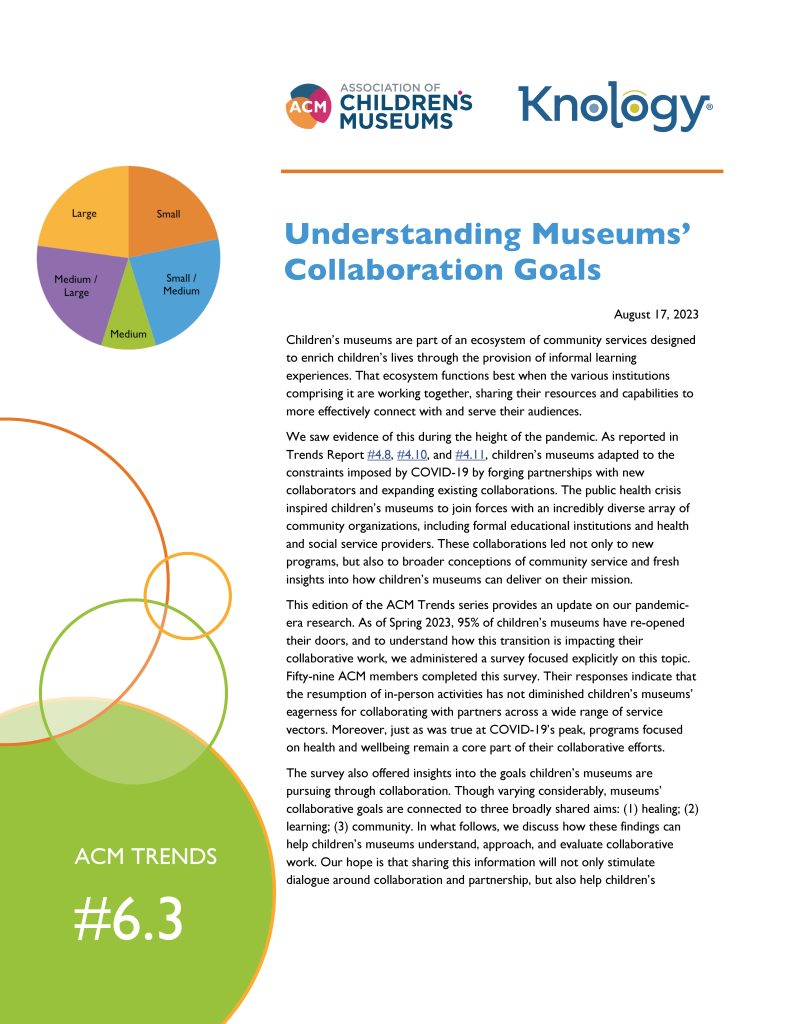
Data for this report was collected through a Spring 2023 ACM member survey on collaborations. The dataset contains information from 59 member institutions. Previous pandemic-era survey data on collaborations conducted during the height of the COVID-19 pandemic supported instrument sevelopment. This research was supported by the Institute for Museum and Library Services
Children’s museums are part of an ecosystem of community services designed to enrich children’s lives through the provision of informal learning experiences. That ecosystem functions best when the various institutions comprising it are working together, sharing their resources and capabilities to more effectively connect with and serve their audiences.
We saw evidence of this during the height of the pandemic. As reported in Trends Report #4.8, #4.10, and #4.11, children’s museums adapted to the constraints imposed by COVID-19 by forging partnerships with new collaborators and expanding existing collaborations. The public health crisis inspired children’s museums to join forces with an incredibly diverse array of community organizations, including formal educational institutions and health and social service providers. These collaborations led not only to new
programs, but also to broader conceptions of community service and fresh insights into how children’s museums can deliver on their mission.
This edition of the ACM Trends series provides an update on our pandemic-era research. As of Spring 2023, 95% of children’s museums have re-opened their doors, and to understand how this transition is impacting their collaborative work, we administered a survey focused explicitly on this topic. Fifty-nine ACM members completed this survey. Their responses indicate that the resumption of in-person activities has not diminished children’s museums’ eagerness for collaborating with partners across a wide range of service vectors. Moreover, just as was true at COVID-19’s peak, programs focused on health and wellbeing remain a core part of their collaborative efforts.
The survey also offered insights into the goals children’s museums are pursuing through collaboration. Though varying considerably, museums’ collaborative goals are connected to three broadly shared aims: (1) healing; (2) learning; (3) community. In what follows, we discuss how these findings can help children’s museums understand, approach, and evaluate collaborative work. Our hope is that sharing this information will not only stimulate dialogue around collaboration and partnership, but also help children’s museum leaders plan new collaborative programs and begin the process of building relationships with new partners.
Play is a powerful experience that enriches people’s lives in museums, schools, homes, and beyond. In this latest ACM Informational Brief, The power of play in children’s museums and elsewhere, play is explained through the research-based benefits of play to children’s discovery, health and wellness, and agency, as well as through the crucial role children’s museums play in cultivating and providing access to play.
Although the benefits of play can occur in many different types of environments, children’s museums offer particularly valuable contexts for play.
Play is vital for children, young people, and adults as well. Children’s museums have vast experience in creating playful learning experiences that are age-appropriate, hands on, interactive, and joyful. Even beyond their walls, museums form partnerships and build capacity to encourage more playful learning experiences in schools, homes, parks, hospitals, airports, malls, and beyond. Children’s museums provide examples of the many ways parents, caregivers, and educators can use play to facilitate wellbeing, healthy brain development, and to make learning more effective and joyful for everyone. As children’s museums, we believe in the power of play and we strive to nurture more play and playful learning everywhere we go.
Paper commissioned by ACM | Written by KT Todd, Director of Learning and Research, Children’s Museum of Pittsburgh
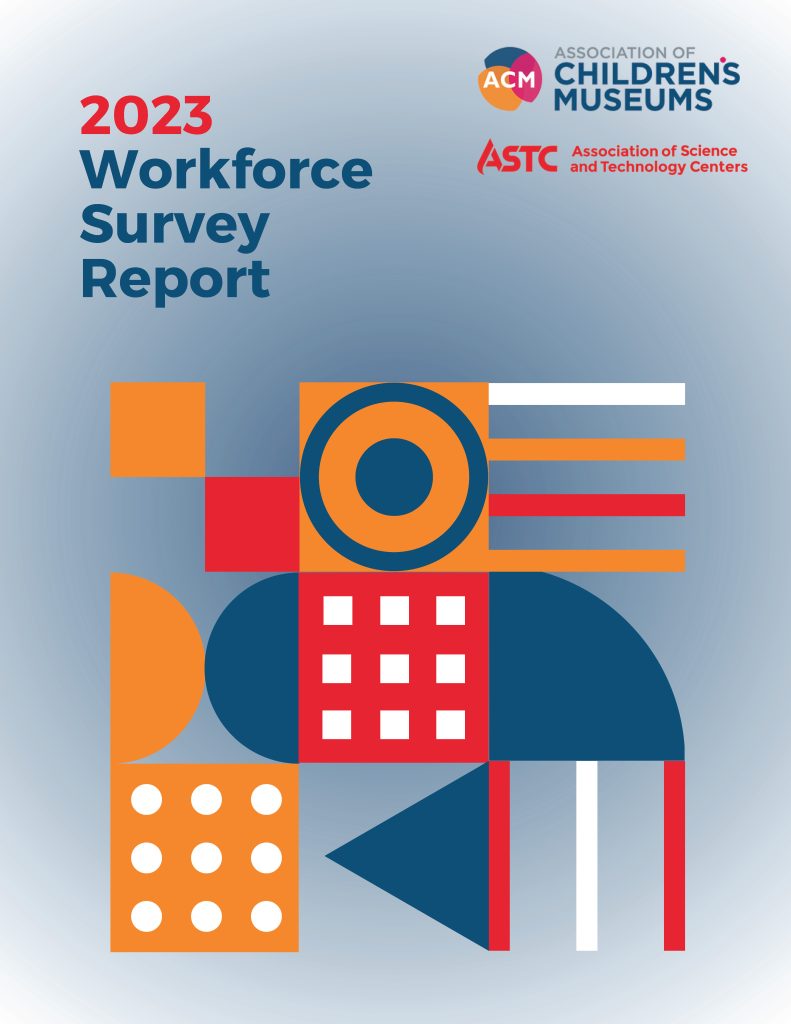
For more information, the 2023 ACM-ASTC Workforce Survey Report can be retrieved via ACM or ASTC. A digital download of the report is available for purchase ($199 ACM or ASTC member/$499 non-member).
ACM members and nonmembers may download the association’s publications order form and send it to membership@acm.org.
ASTC members may purchase their report via myASTC.astc.org.
The Association of Children’s Museums (ACM) and the Association of Science and Technology Centers (ASTC) are pleased to announce the release of the 2023 ACM-ASTC Workforce Survey Report. This report presents findings from 138 participating institutions, 36% of which are active ACM member museums, and 81% of which are active ASTC member museums. ACM and ASTC worked together on previous efforts to capture this data and share with the community, most recently in 2016.
The purpose of this joint data collection effort is to provide museum professionals and leadership with an understanding of important staffing trends in the museum world, as well as analysis that can help institutions understand how their own policies relate to institutions of similar size or type.
Key Findings
• Full-time staff numbers are rebounding to their pre-pandemic levels, but part-time positions remain down by almost 15%, and volunteer numbers are lower as well.
• 65% of institutions report that they are currently hiring floor/frontline staff, far above the percentage that reported currently hiring for any other positions.
• Full-time staff salaries are up by 15% since 2019 and approximately 6% in the past year.
• Part-time hourly wages increased 23% since 2019 and approximately 7% in the past year.
• Benefits that institutions offer staff have not changed dramatically since the 2016 workforce survey. Currently, more than 80% of institutions report contributing to employee health insurance.
• Questions on remote work arrangements show that the majority of museum work is still being done primarily in-person. At the same time, many respondents said the demand for remote work flexibility is a major challenge in recruiting new staff.
• 11% of institutions reported have some unionized staff, but unionization is typically limited to only certain roles or departments.
• Demographic information on staff is quite limited, raising questions for how institutions can measure their progress toward diversifying the field.
The 2023 ACM-ASTC Workforce Survey Report paints a picture of a field that is moving forward from the pandemic, but not without challenges. Compensation is rising and staff numbers are rebounding, but these trends are not consistent across all types of staff. Museums are looking for ways to attract and retain staff in a time when many workers are navigating career transitions, but they are also encountering obstacles as workers sometimes find more competitive pay, benefits, or work policies in other fields.
The full 2023 ACM-ASTC Workforce Survey Report provides a closer look at these numbers and issues, with breakouts by institution type, size, and location to help organizations understand where their own policies and practices lie in comparison to the larger field. A robust executive summary is available open access for free.
Monday, July 17, 2023, 3:00 PM ET
Please join ACM and ASTC for a free webinar—open to all—to learn more about the survey instrument and our findings. Attendees will hear from ACM’s Jennifer Rehkamp, Director of Field Services and Research, and ASTC’s Melissa Ballard, Director of Programs.
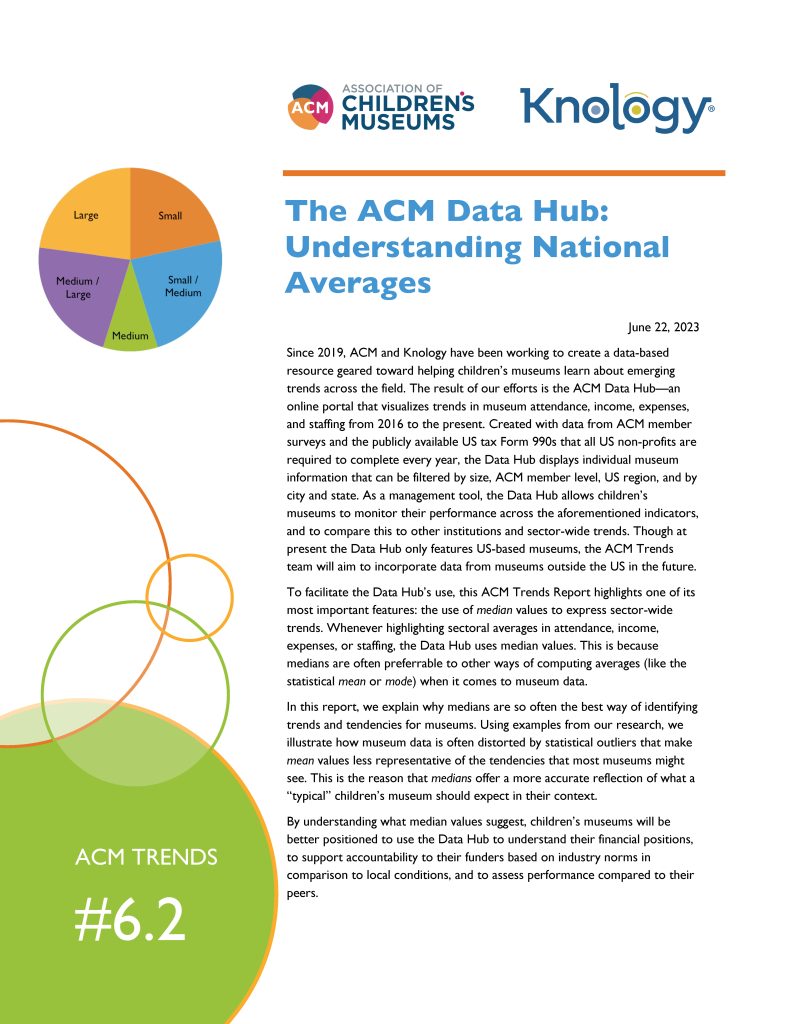
Data for this report was drawn from publicly available IRS Form 990s posted on Candid and the ProPublica nonprofit look-up tools. Supplemental data was collected through the Spring 2022 ACM member survey.
Since 2019, ACM and Knology have been working to create a data-based resource geared toward helping children’s museums learn about emerging trends across the field. The result of our efforts is the ACM Trends Data Hub—an online portal that visualizes trends in museum attendance, income, expenses, and staffing from 2016 to the present. Created with data from ACM member surveys and the publicly available US tax Form 990s that all US non-profits are required to complete every year, the Data Hub displays individual museum information that can be filtered by size, ACM member level, US region, and by city and state. As a management tool, the Data Hub allows children’s museums to monitor their performance across the aforementioned indicators, and to compare this to other institutions and sector-wide trends. Though at present the Data Hub only features US-based museums, the ACM Trends team will aim to incorporate data from museums outside the US in the future.
To facilitate the Data Hub’s use, this ACM Trends Report highlights one of its most important features: the use of median values to express sector-wide trends. Whenever highlighting sectoral averages in attendance, income, expenses, or staffing, the Data Hub uses median values. This is because medians are often preferrable to other ways of computing averages (like the statistical mean or mode) when it comes to museum data.
In this report, we explain why medians are so often the best way of identifying trends and tendencies for museums. Using examples from our research, we illustrate how museum data is often distorted by statistical outliers that make mean values less representative of the tendencies that most museums might see. This is the reason that medians offer a more accurate reflection of what a “typical” children’s museum should expect in their context.
By understanding what median values suggest, children’s museums will be better positioned to use the Data Hub to understand their financial positions, to support accountability to their funders based on industry norms in comparison to local conditions, and to assess performance compared to their peers.
Mental health is important.
Children’s museums have long been invested in creating environments where children thrive. Mental health is a pressing current issue for the children in our communities, and children’s museums have expansive opportunity to meet those needs with comprehensive, collaborative experiences that supplement the essential work of mental health professionals—providing all children with the skills to navigate their world with joy, wonder, and wellness.
ACM’s latest information brief “The role of children’s museums in supporting children’s mental health“, provides an overview of some primary research trends about children’s mental health and then shares insights about how children’s museums—community-serving organizations that reach millions of U.S. children each year—can bolster children’s mental health.
Paper commissioned by ACM | Written by KT Todd, Director of Learning and Research, Children’s Museum of Pittsburgh